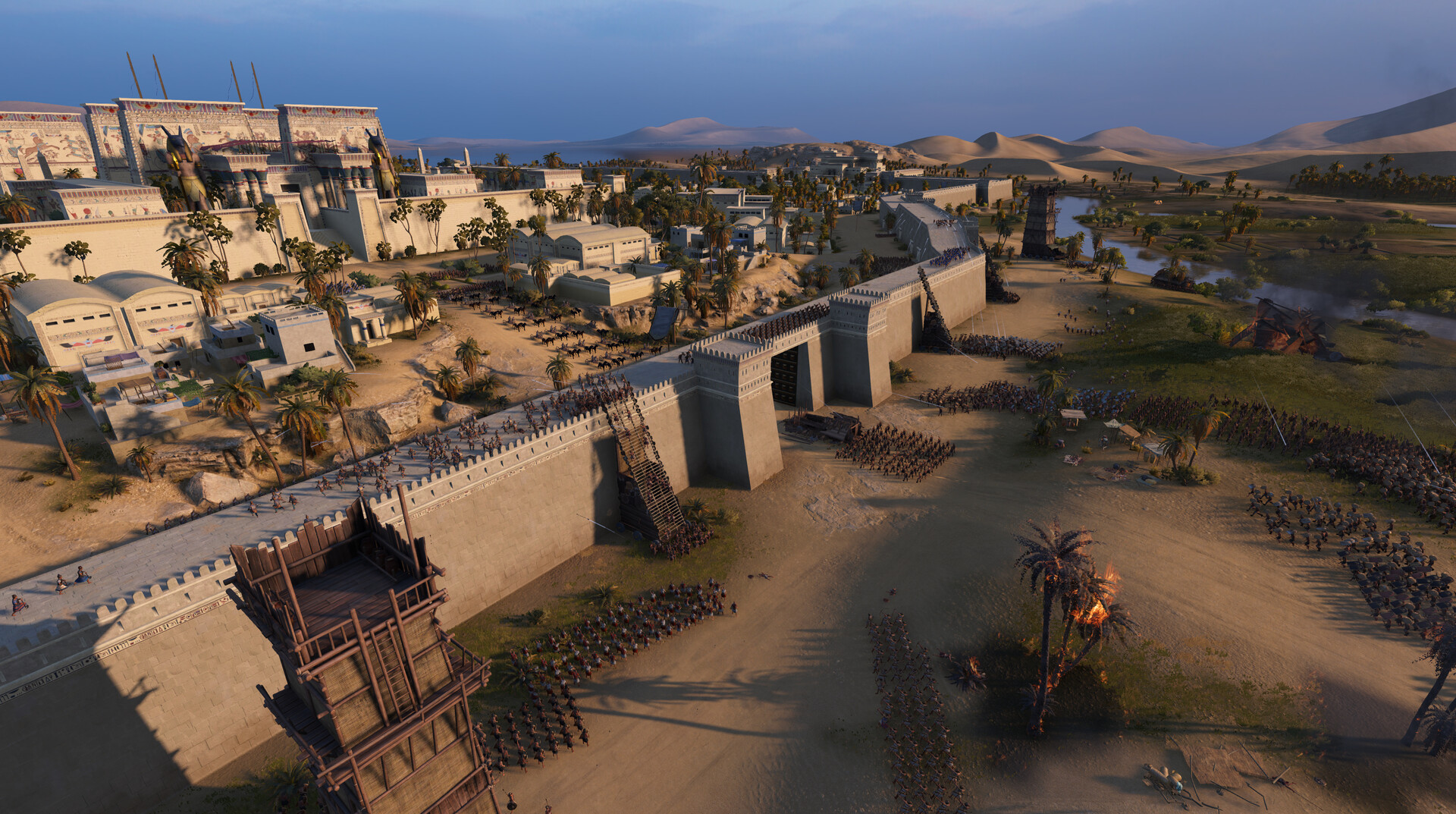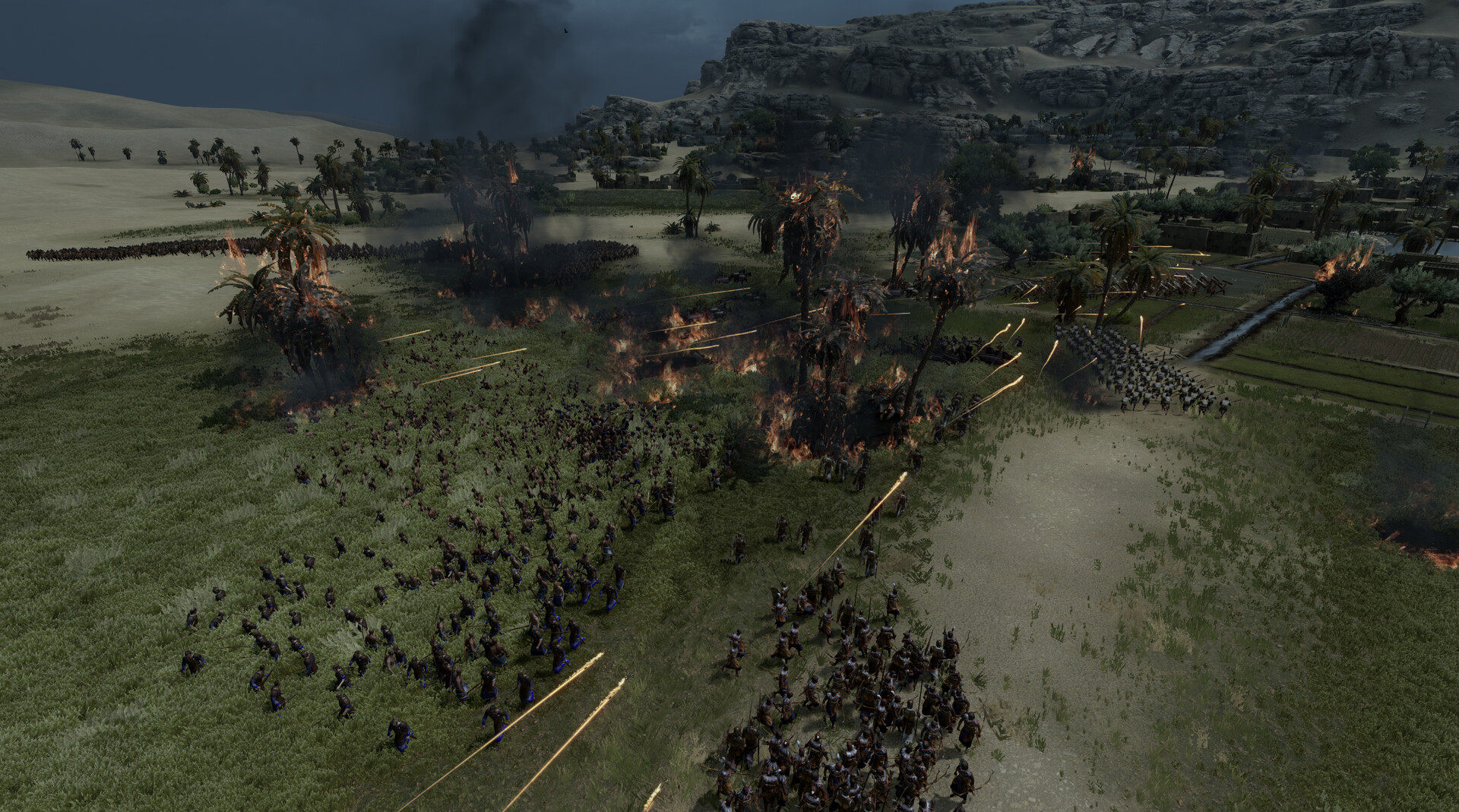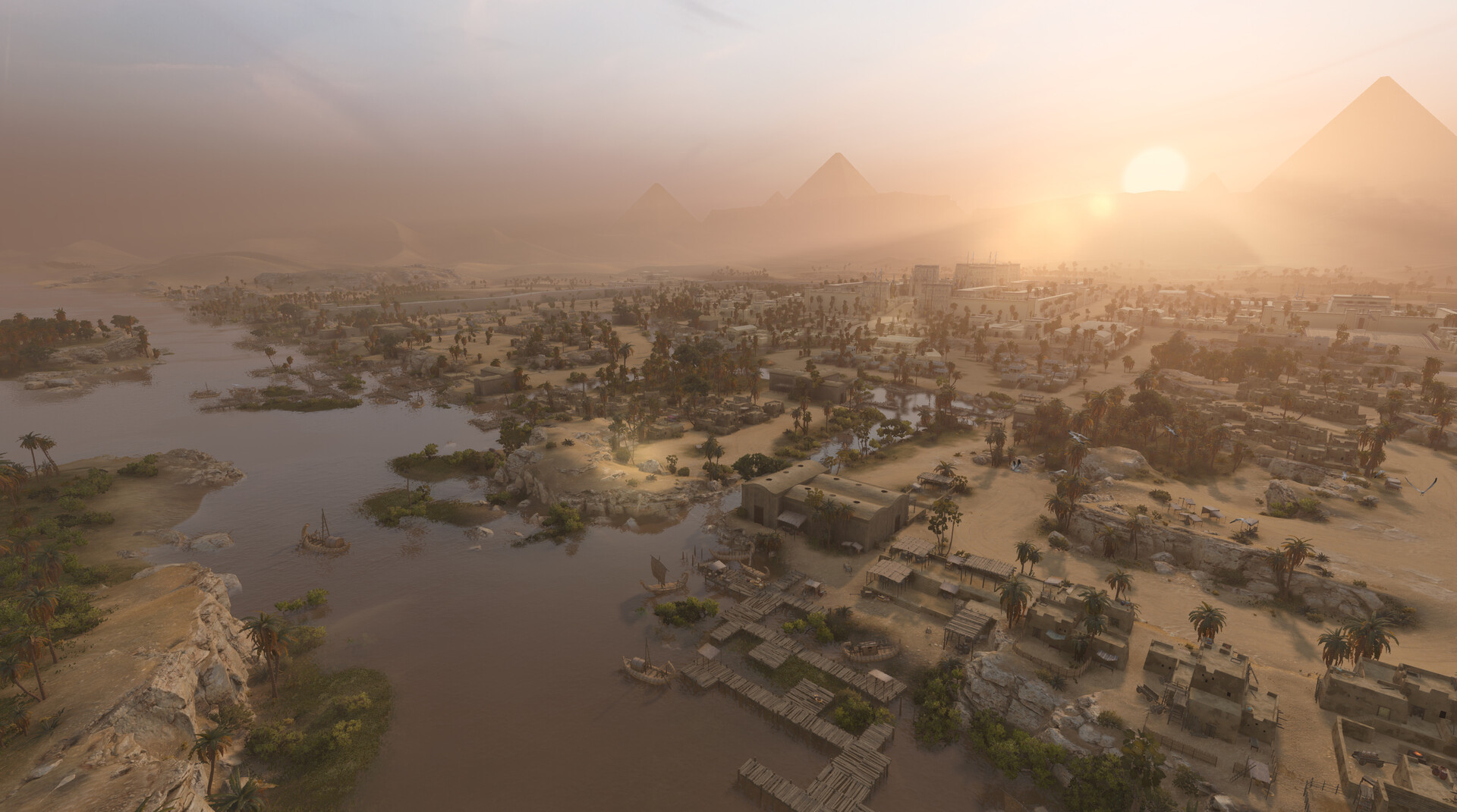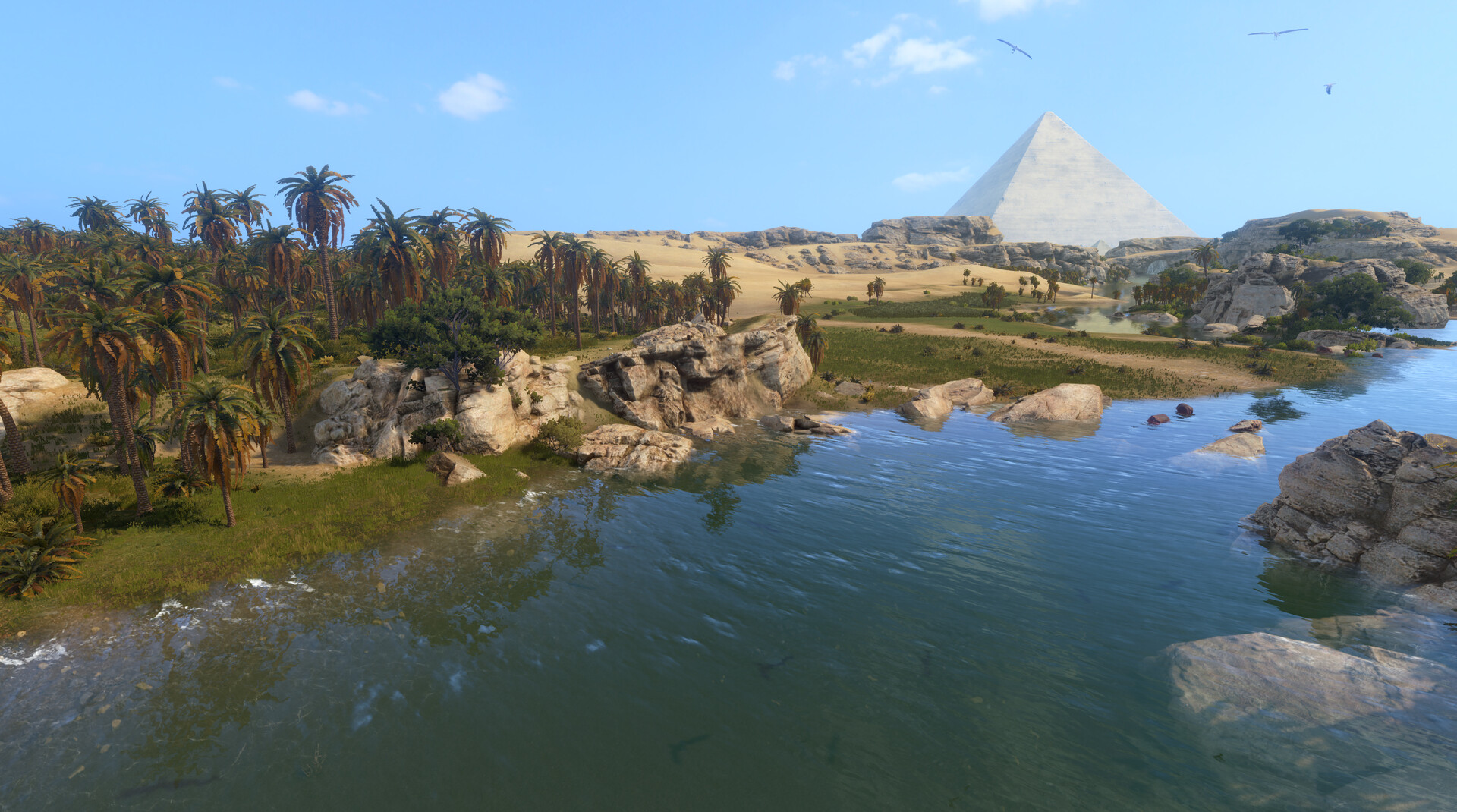The Total War series is old enough now to split into two eras. Beginning in 2000 with Shogun: Total War, the strategy game series began life firmly rooted in recorded history, which culminated with the release of Total War: Attila in 2015. The launch of Total War: Warhammer in 2016 ushered in a new age for Total War, one in which even the historical games like Total War: Three Kingdoms and Total War Saga: Troy featured fantastical elements and superhuman characters. With Total War: Pharaoh, Creative Assembly is returning to the series’ grounded, historical beginnings – but not without adding some new ideas of its own. We had the chance to spend some hands-on time with the game for this Total War: Pharaoh preview, and we also interviewed creative director Maya Georgieva on its incoming innovations.
Set in the closing years of the Bronze Age around 1200 BCE, Total War: Pharaoh casts players as one of eight leaders in contention for power over all of Egypt and the surrounding regions following the death of the last pharaoh. This was ancient Egypt at the absolute height of its glory, with the awe-inspiring pyramids at Giza clad in dazzling white limestone and capped in precious metals. Cities feature broad paved avenues, and their sturdy walls are illuminated with colorful hieroglyphic figures.
“We’re trying to make a classical, historical Total War with Pharaoh, and we feel that this is actually a way to stand out,” creative director Maya Georgieva tells us. “There has been a trend towards more characterization, more fantastical elements, which is basically [taking] the balance between authenticity and gameplay and pushing in favor of gameplay.”

When players pick up Total War: Pharaoh, Georgieva says, the goal is that they experience a pleasant sense of nostalgia – that it’s an opportunity to completely immerse oneself in the atmosphere of a specific historical era.
For the design team at Creative Assembly Sofia, it’s also presented an opportunity, as well as a challenge: to create a game that harkens back to Total War’s more grounded, historical roots while simultaneously offering a fresh experience.
The answer the team has settled on has been to add a new sense of dynamism to every level of Total War: Pharaoh. On the strategic map, decisions players make can push the world closer to the calamity of the Bronze Age collapse, or bring it back from the brink. In tactical battles, changing weather and terrain conditions present new moment-to-moment considerations for positioning and timing of attacks.
We had the chance to play three sample battles as one of Pharaoh’s eight commanders, the young Ramesses. He’s accompanied by some of the game’s most well-trained units, and the battles Creative Assembly presented in the demo let us test him against three different armies in a simple attack, a defense against a numerically superior foe, and in a siege defense against an assault on multiple fronts.
While Total War veterans will be right at home with Pharaoh, there are some important new considerations. Sandstorms and thunderstorms can rapidly alter conditions on the ground, and fires can spread from ground cover to buildings, particularly in hot weather. Troops tire out faster when it’s sweltering hot in the desert sun, grow fearful when lightning strikes around them, and will take continuous damage while trying to fight through a sandstorm. Rain can turn muddy areas into bogs where chariots can get stuck, and armored troops can only soak up so many hits before their protection breaks.
A new feature we found particularly helpful is the stance system. You can order units to advance, hold ground, or give ground by clicking an icon while they’re selected. Archers, for example, can move to a position where they should fire at will and give ground – meaning they’ll shoot at any targets in range, but back up if anyone gets too close.
Creative Assembly lead battle designer Milcho Vasilev says that’s just one way to use the give ground stance.
“The way I love to use give ground the most is actually when I’m defending a settlement,” he tells us. “I place the troops behind the gate, but then position some on the sides.”
The first group of troops will engage the first enemy unit that breaches the gate, but will slowly retreat backwards in the give ground stance, which allows Vasilev’s other troops to close in on the enemy’s exposed flanks like a bear trap.
On the strategic campaign map, a new dynamic system governs all of the ancient world of Egypt, Canaan, and Anatolia. The land begins in a time of prosperity, during which the weather is pleasant and natural disasters are rare. That changes, however, depending on the choices players make. Increases in armed conflict and political instability can shift the region into crisis, which will come with an uptick in natural disasters and invasions by the Sea Peoples. If things continue along this path, eventually crisis will give way to collapse, and despair and darkness consume the land as the Bronze Age comes to its violent close.
All these new features have involved building fresh tech for Total War, but Vasilev says that hasn’t been as challenging as teaching Total War’s AI how to deal with all the new possibilities presented by these dynamic systems. For example, as part of its push for a more realistic simulation, there are no longer “pocket ladders” – units won’t automatically produce ladders from thin air when they approach a settlement wall.
“We wanted to remove that because we wanted to be more historically authentic,” Vasilev explains. “And we did. But of course, this makes challenges for the AI. We needed to make sure that it now knows how to attack settlements, because attacking settlements is now a lot harder.”
“We’ve introduced a lot of new ways to maneuver your armies around the battlefield,” he says. “Even before the battle starts, we think about what kind of siege equipment you’re going to construct, how much time you’re going to invest in that. Or are you going to try and undermine the whole settlement, or just be the Sea Peoples and try to burn it down?”
The Bronze Age and the New Kingdom period in Egypt are perhaps less well-trod territory for popular history than Total War has explored before, but it’s rich with political and martial drama, Georgieva says. Her team has studied each of the empires in Pharaoh – the Egyptians, the Canaanites, and the Hittites – and found striking differences in the way they approached warfare and governance.
“Of course, the reality of the time was not that the factions are so differentiated as they are in the game, this is more of a gameplay concern,” she said. “Every faction should give the player a different avenue to express themselves in their campaign, and to have a different experience every time. So one thing that we will do, obviously, is exaggerate some features that we’ve come across in the research.”
That research includes contemporaneous Egyptian and Hittite accounts of the Battle of Kadesh, which took place in 1274 BCE and is regarded as the earliest organized battle for which detailed records of troop formations and tactics were kept.
“We actually do have a lot of information on both the Egyptian and the Hittite Empire,” Georgieva says. “We know from those historical sources, for example, what the equipment of the Hittites is, and that they are prone to have heavier chariots with three people in them, while the Egyptians in front have lighter chariots that are super fast or maybe have archers in them.”
Players will be able to take either the Egyptian or Hittite side as the two major empires vie for control of Canaan, the modern-day Levant region between Egypt and Turkey. Alternatively, Georgieva says, it’s possible to play as the Canaanites, and either try to align with one of the two superpowers and gradually assume control as high king or pharaoh… or bring everything tumbling down by setting off the great collapse that ended the Bronze Age.
“As with the battles, where we’re trying to put tools in the hands of the player, but we are not forcing them to use them in a particular way, this is also the philosophy that is implemented in the campaign as well,” Georgieva explains. “Player choice is paramount.”
The Total War: Pharaoh release date is set for October and it will be available on both Steam and the Epic Games Store. We also compiled some thoughts on what Total War: Pharaoh needs to do to succeed.





